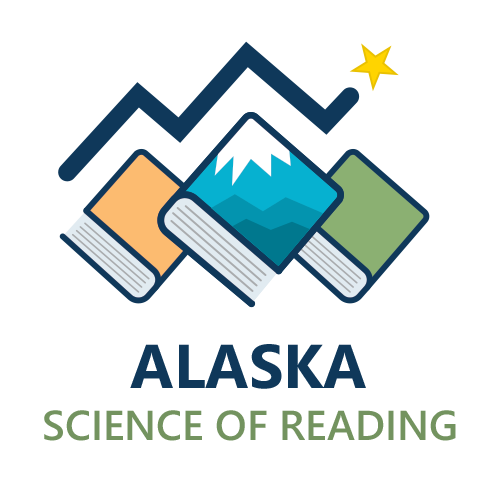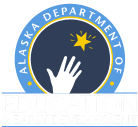- Cama-i, quyana tailuci!
- (Central Yup’ik)
- "Greetings, thank you for coming!"
Reading Resources
What is Teaching Strategies GOLD?
Teaching Strategies GOLD is an on-going whole-child observation-based tool used by early education program staff to document children’s progression along a developmental continuum in the areas of Social-Emotional, Physical, Language, Cognitive, Literacy, and Math.
What does Teaching Strategies GOLD have to do with reading?
In the Literacy area, children in early education programs are observed to see if they demonstrate 4 distinct objectives. Teachers will set up their classroom environment and structure activities in the classroom to give children opportunities to demonstrate what they know or can do.
The first literacy objective is whether they demonstrate phonological awareness, phonics skills, and word recognition. This is determined through observations in 4 dimensions:
- Notices and discriminates rhyme,
- Notices and discriminates alliteration,
- Notices and discriminates discrete units of sound, and
- Applies phonics concepts and knowledge of word structure to decode text.
Students in early stages of this may demonstrate this by joining in rhyming songs and games during large group activities whereas a student with more exposure to these skills will be able to do clap out syllables in a word independently.
The second objective is whether they demonstrate knowledge of the alphabet. This is determined through observations in 2 dimensions:
- Identifies and names letters, and
- Identifies letter-sound correspondence.
Children in beginning stages of this may recognize and name letters in their name, whereas later on, they will be able to identify all letters presented in a random order and an increasing number of correct sounds.
The third objective is whether they demonstrate knowledge of print and its uses. This is determined through two dimensions:
- uses and appreciates books and other texts, and
- uses print concepts.
Children at beginning stages will show interest in reading and book and progress to understanding the directionality of text.
The fourth objective is whether they comprehend and respond to books and other texts. This is determined through 5 dimensions: a. interacts during reading experiences, book conversations, and text reflections, b. uses emergent reading skills, c. retells stories and recounts details from informational texts, d. uses context clues to read and comprehend texts, and e. read fluently. Children at beginning stages will be able to retell stories and progress to answering simple questions about them.
How is Teaching Strategies GOLD integrated into the classroom?
Students are observed multiple times throughout their regular classroom day and placed upon a level in the developmental continuum by teachers at least twice a year. Teachers utilize these observations in planning for the classroom environment, large and small group activities, and parental engagement.
How does Teaching Strategies GOLD connect to the Alaska Development Profile?
Teaching Strategies GOLD is used by educators in Early Education Programs. These observations that are taken in the fall and Spring before Kindergarten. The Alaska Developmental Profile is used by Kindergarten teachers (and some first grade teachers if students did not attend Kindergarten) during the Fall of their Kindergarten year.
The literacy dimensions in Teaching Strategies are aligned with the 13 goals in the Alaska Developmental Profile.
|
ADP Goals |
Teaching Strategies Dimension |
| Goal 10: Uses expressive communication skills | 9a: Uses an expanding and expressive vocabulary (Level 7) |
| Goal 11: Demonstrates phonological awareness |
15b: Notices and discriminates alliterations (Level 6) 16b. Identifies letter-sound correspondence (Level 5) |
| Goal 12: Demonstrates awareness of print concepts | 15c. Notices and discriminates units of sound (Level 5) 16a. Identifies and names letters (Level 5) 17a. Uses and appreciates books and other texts (Level 7) 17b: Uses print concepts (Level 6) |
| Goal 13: Demonstrates knowledge of letters and symbols (Alphabet knowledge) | 16a. Identifies and names letters (Level 5) 17b: Uses print concepts (Level 6) |
Teaching Strategies and the Science of Reading: Position Statement
Teaching Strategies SoR Full Alignment Matrix
CONTACT:
Supanika Ordoñez
Education Specialist II, Early Learning
Alaska Department of Education & Early Development
supanika.ordonez@alaska.gov

Events
Alaska Reads Act Presentations
Available by Appointment
Email requests to: akreads@alaska.gov
Alaska PLC Summit
November 1 - 2, 2023
Dena'ina Convention Center, Anchorage Alaska
2024 Alaska Science of
Reading Symposium
April 19 - 21, 2024
Dena'ina Convention Center, Anchorage Alaska
AKLearns Professional
Development Calendar
Coffee and Content
3rd Monday starting Sept. 2023
4:00 - 5:00
New Events Coming Soon!
Watch this space...
Resources
Alaska Reads Act Implementation Webinars
January through May 2023
Access Webinar Recordings Here
AKLearns
Information Supporting Reading in Alaska
Alaska ELA Standards
Documents
NEW! Alaska Reads Act HB114 Regulations - Final
Introduction to Alaska's Strategic Reading Plan
Subscribe to Updates
